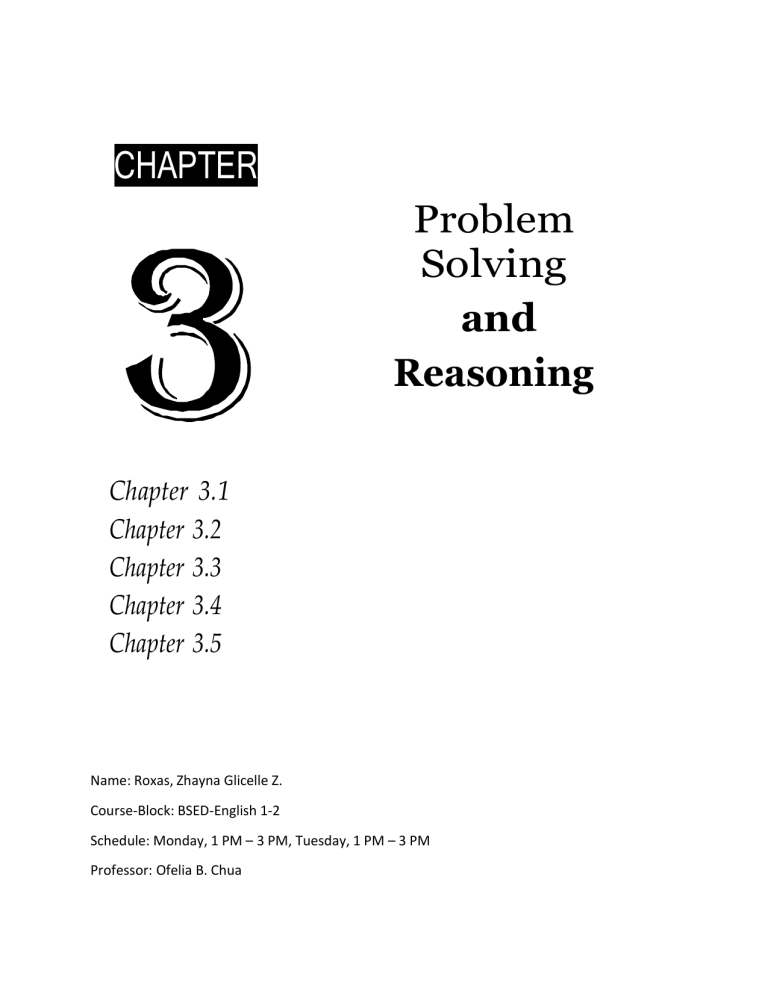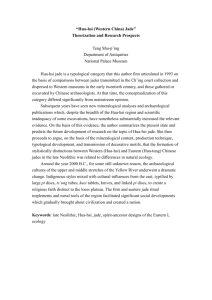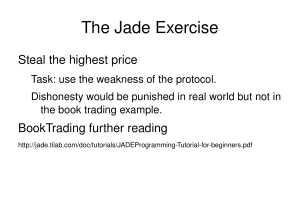
CHAPTER
Problem
Solving
and
Reasoning
Chapter 3.1
Chapter 3.2
Chapter 3.3
Chapter 3.4
Chapter 3.5
Name: Roxas, Zhayna Glicelle Z.
Course-Block: BSED-English 1-2
Schedule: Monday, 1 PM – 3 PM, Tuesday, 1 PM – 3 PM
Professor: Ofelia B. Chua
Exercise 3.1
Solving Mathematical Problems by Inductive Reasoning
Score:
Name: _
Course-Block: ___________________ Schedule:
Professor:
A. Predict the next number in the sequence.
1. 1. 3, 5, 9, 15, 23, 33, 45,
_ answer: 59
2.
5
7
7 9 11
,
, ,
5 7
,
9
13 15 ,
,
11 13
answer:
3. -18, -8, -13, -3, -8, -2, -3, 7, 2,
17
15
answer: 12
4. 8, 15, 24, 35, 48,
answer: 63
5. 1, 4, 16, 64, 256,
_ answer: 1024
6. 1, 5, 11, 19, 29,
answer: 41
7. 1, 4, 10, 20, 35,
answer: 56
1 1
8. 1, ,
2 3
9.
3
,
5
1
, , 1,1 ,
5 6
4
,
7
12 34 56
,
9
,
78
10. 1, 8, 27, 64, 125,
_ answer:
1
7
answer:
11
9 10
_ answer: 216
_____
B. Find the nth term of the sequence
1. 10, 10, 12, 16, 22, 30, …
answer: ax2+bx+c
sequence 1st diff
2nd diff
10
0
10
2
2
12
4
2
16
6
2
22
8
2
30
2. 17, 15, 25, 53, 105, 187, …
answer: ax3+bx2+cx+d
sequence
1st diff 2nd diff
3rd diff
17
3.
15
-2
12
6
25
10
18
6
53
28
24
6
105
52
30
187
82
1 1
3 2 5
, , , , , 3,…
3 2 5 3 7 4
n
1
answer:
can
be
expressed
as
(n+2)
3
4. 2, 14, 36, 68, 110, …
answer: ax2+bx+c
sequence
1st diff
2 3
2nd diff
2
12
14
22
10
36
32
10
68
42
10
110
4
5 6
,4 ,5 ,6 ,7 , 8
3
5. , 5 21 , 18
2
2
55
2
, 39, …
answer: ax2+bx+c
sequence
1st diff
2nd diff
3/2
7/2
5
11/2
4/2 or 2
21/2
15/2
4/2 or 2
18
14/2
4/2 or 2
55/2
23/2
4/2 or 2
39
C. Solve the following problems by induction:
1. Think of a positive number. Multiply it by 4. Add 8 to the result. Divide the new result by
2. On the table below, list down the numbers you thought of and the result of performing
the indicated mathematical operation.
Number being thought of
2
6
12
14
Result of performing the
math operations
8
16
28
32
2. Study the table carefully and find the formula to find the number being thought of easily.
4(x)+8
answer:
2
3. Find the units digit of 71997.
- base is 7 therefore l=7
- exponent is 1997 when divided by 4, has a remainder of 1
Answer: the units digit of 71997 = 7’= 7
4. Ancient Filipinos exchange their gold for porcelain wares and jade of the Chinese. The
exchange rate are as follows:
2 pieces of gold = 20 pieces of jade
15 pieces of gold = 6 baskets of jade
10 baskets of jade = 1 bowlful of gold
How many pieces of jade are there in 1 bowlful of gold?
2 pcs of gold= 20 pcs of jade
if 2:20 then 1:10
15pcs of gold= 6 basket of jade
1 pc of gold: 10 pcs of jade
10 baskets of jade= 1 bowlful of gold
then 15 pcs of gold: 150 pcs of jade
(x)pcs of jade= 1 bowlful of gold
6 baskets
Answer: in conclusion, 250 pcs of jade= 1 bowlful of gold
5. One cut of a metal rod produces two pieces of metal rods. Two cuts produce three pieces.
three cuts produce four pieces. How many pieces are produced in 7 and 9 cuts? Predict the
nth term formula for the number of pieces of metal rods that are produced by n cuts of a
metal rod.
- if 1 cut= 2pcs, 2 cuts= 3pcs, 3 cuts= 4 pieces therefore 7 cuts= 8 pcs and 9 cuts= 10 pcs
Let x be the number of cuts
Answer: x= x+1
6. Prove that the following statements are false:
a. The sum of two odd counting numbers is always even.
- The statement can’t be false due to the fact that the sum of any 2 odd counting
numbers is always even.
b. For all number x, |x+5|=|x|+5
let x = -2, |-2+5| = |-2|+5
= | -3| = 2+5
=3
=7
3≠7
c. For all number x,
let x = 5,
(5)2
–25
5–5
x2–25
x–5
= x+5
= 5+5
undefined=10
d. For all number x, x2 x.
1
1 2
1
2
2
2
let x = , ( ) ≥
,
e. For all number x,
�
�
≥
√�z
�
�
+ 36 = x+6.
Let x = -3, √(−3)2 + 36 = x+6
= √9 + 36
= 3+6 = -3+
Exercise 3.2
Solving Mathematical Problems by Deductive Reasoning
Score:
Name: _
Course-Block:__________________ Schedule:__________________
Professor:
A. Find the first three terms of the sequence whose nth terms is as follows:
1. 4n2-1
S1= 4(1)2-1=3
S2= 4(2)2-1=15
S3= 4(3)2-1=35
2. n3-3n+4
S1= (1)3-3(1) +4= 2
S2= (2)3-3(2) +4= 6
S3= (3)3-3(3) +4= 22
3.
1
n2+2n
S1=
S2=
1
2
(2) +2(2)
S3=
4.
1
(1)2+2(1)
1
(3)2+2(3)
=
=
1
3
1
8
1
= 15
1
2(n)n
S1=
1
(2(1))
(1) =
1
2
1
S2=
(2(2))
1
(2)
= 16
(3)
=
1
S3=
(2(3))
1
216
5. 3n+1
S1= 3(1)-1=1
S2= 3(2)-1=3
S3= 3(3)-1= 9
6. n(n+1) (n+2)
S1= 1(1+1) (1+2) = 6
S2= 2(2+1) (2+2) = 24
S3= 3(3+1) (3+2) = 60
7.
1
√2n
S1=
S2=
S3=
1
√2(1)
1
√2(2)
1
√2(3)
=
=
=
1
√2
1
2
1
√6
8. n 2n
S1= (1) 21= 1 2
S2= (2) 22= 2 4
S3= (3) 23= 3 8
9.
n+3
n(n+1)(n+2)
1+3
S1 = 1(1+1)(1+2)
S2 =
S3 =
2+3
2(2+1)(2+2)
3+3
3(3+1)(3+2)
=
=
=
4
or
6
5
24
6
60
2
3
��
1
10
10. √3� − 1
S1= √3(1) − 1 = √2
S3= √3(3) − 1 = √8
S2= √3(2) − 1 = √5
B. Evaluate the following using the terms in the Fibonacci Sequence
1. 4Fn -2Fn-2 when n= 10
= 4F10 -2F10-2
= 4(55)-2(11)
= 220-42
= 178
2. FnFn+2 -Fn-1Fn-2 when n = 7
= F7F7+2 -F7+1F7-2
= F7F9 -F8F5
= (13) (34) – (21) (5)
= 442-105
= 337
3. 6Fn+Fn+3 -2Fn-1 when n = 8
= 6F8+F8+3 – 2F8-1
= 6F8+F11- 2F7
= 6(21) +89-2(13)
=11
4.
Fn
when n = 15
Fn+3
F
= 15
F15+3
F15
=
F12
���
610
=
5.
144
F3n
Fn+2
=
��
− 3�
or 4.236
5
when n = 4
F3(4)
=
= 3�
=
5
F4+2
F12
F6
144
=
8
– 15
8
− 3�
=
144
=3
5
– 3(5)
C. Solve the following problems by deduction:
1. Use deductive reasoning to show that the following always produces the number 3.
Pick a number. Add 5 to it. Subtract 7 from the result. Subtract twice the original number
from the previous result.
Let n be any number
= (n+5)-7-2n
= (9+5)-7-2(9)
= 14-7-18
=3
2. Use deductive reasoning to show that the following produces always the original number
increased by 2. Pick a number. Multiply it by 4. Add 8 to it. Divide the result by 4.
Let n be any number
=
4n+8
4
cancel 4 and divide 8 by 4
= n+2
3.
The nth term formula for the maximum number of pieces of baked cheesecake, Pn, that
n(n+1)
can be produce by n straight cuts in Pn=
2
a. Use the nth term formula to determine the maximum number of pieces that can be
produced by 7 straight cuts.
P7 =
=
=
7(7+1)
2
7(6)
2
42
2
P7 = 21
b. What is the smallest number of straight cuts that you can use if one wishes to produce
at least 45 pieces?
P10 =
=
10 (10+1)
2
10 (9)
2
=
90
2
= 45
4. Four friends Sheldon, Raj, Leonard and Howard decided to invest their 50,000 dollars
savings in stocks. Each chooses a different stock. One chooses a blue-chip stock, another a
growth stock, the other chooses an income stock and another chooses a penny stock. From
the
following clues, determine who bought which stock.
a. Sheldon and the owner of the blue-chip stock purchased their shares through an
online brokerage, while Raj and the owner of the growth stock did not.
b. The gain in value of Leonard’s stocks is twice the gain in the value of the growth
stock.
c. The income stock is traded on American Stock Exchange, whereas the stock that
Raj bought is trades on the Chicago Stock Exchange
Sheldon
Raj
Leonard
Howard
Blue Chip
✔
✘
✘
✘
Growth
✘
✘
✘
✔
Income
✘
✘
✔
✘
Penny
✘
✔
✘
✘
Sheldon choose Blue chip stock
Raj choose Penny stock
Leonard choose Growth stock
Howard choose Income stock
5. Three chess players, Garry, Anatoly and Vishy competed for fun. Two of them won and
one lost. Determine who won and lost by using the following clues:
a. Anatoly won his match, if Garry lost his match.
b. If Garry won his match, then Vishy lost his match.
c. Anatoly lost his match, if Vishy won his match.
Answer: Anatoly- Won
Garry- Won
Vishy- Lost
Exercise 3.3
KenKen Puzzle and Magic Square
Score:
Name: _
Course-Block: ____________________Schedule:
Professor:
Solve the following KenKen puzzles and Magic Squares
1. KenKen
22+
5
6+
4
3
2
1
5
4
1
3
40X
3
5
30X
1
6X
4
1
5
2
5
2
5÷
2
4
5
3
4
2
3
5
1
4
160X
45X
2
5
1
4
3
3
5
20X
1
2. KenKen
4
2
1
15X
20X
3
1
5
2
12÷
4
4
2÷
1
3
4
5
2
5
4
3
2
1
3. Magic Square
6
32
3
34 35
7
11 27 28
1
8
30
19 14 16 15 23 24
18 20 22 21 17 13
4. Magic Square
25 29 10
9
26 12
36
4
2
5
33
31
30 39 48
1
10 19 28
38 47
7
9
18 27 29
46
6
8
17 26 35 37
5
14 16 25 34 36 45
13 15 24 33 42 44
4
21 23 32 41 43
3
12
22 31 40 49
11 20
2
5. Magic square
1
12
23
34
45
47
58
69
80
11
22
33
44
46
57
68
79
9
21
32
43
54
56
67
78
8
10
31
42
53
55
66
77
7
18
20
41
52
63
65
76
6
17
19
30
51
62
64
75
5
16
27
29
40
61
72
74
4
15
26
28
39
50
71
73
3
14
25
36
38
49
60
81
2
13
24
35
37
48
59
70
Exercise 3.4
Cryptarithm
Name: _
______________________________________________
Score:
Course-Block:_______________________ Schedule:
Professor:
A. Each letter in the cryptarithm represents one of the digits 0 through 9. Determine which
digit is represented by each of the letters in the given cryptarithm.
1.
Answer:
K=9 L=8 C=1 F=0 A=7
2.
Answer:
B=6 E=4 A=0 C=9 D=2
3.
Answer:
P=1 Q=6 R=5 S=7 T=8 U=0 v=3
4.
Answer:
A=6 O=8 Y=3 E=2 S=7 M=4 R=0 T=1 U=5
5.
Answer: O=1 N=8 E=2 T=7
Exercise 3.5
Polya’s Problem Solving Strategy
Name: _
_______________________
Score:
Course-Block: _______________________ Schedule: _______________
Professor:
________
A. Solve the following using Polya’s problem solving strategy.
1. How many varieties of pizza flavors can be made from 4 meat toppings, 2 kinds of
mushroom, 4 kinds of cheese and 3 fruits?
Step 1: Understandthe problem
Step 2: Devise a Plan
Step 3: Carry out the plan
Step 4: Review the Solution
Step 1:
Given: 4 meat toppings, 2 kinds of mushrooms, 4 kinds of cheese and 3 fruits
Required: Number of varieties of pizza can be made
Step 2:
Solution: Multiply each type to get the number of combinations
Step 3:
Equation: (4)(2)(4)(3) = 96 combinations
Step 4:
Review (1+1+1+1) (1+1)
(1+1+1+1)
Meat
mushroom
cheese
(1+1+1)
fruits
=
96 combinations
2. How many plate numbers consisting of three letters and three digits can be created
using the letters in the English alphabet and the digits from 0 to 9?
Step 1:
Given: English Alphabet {a,b,c,d,e,f,g,h,I,j,k,l,m,n,o,p,q,r,s,t,u,v,w,x,y,z}
Numbers {0,1,2,3,4,5,6,7,8,9}
Required: Number of plate numbers that can be created with three (3) letters and three (3)
digits.
Step 2:
Solution: Cube each set (three letters\digits) then multiply the result to get the
combinations.
Step 3:
Equation: (26)3 (10)3 = (17576) (1000) = 17576000
Step 4:
Review:
(26•26•26)
(10•10•10) = 17576000
Per each letter Per each letter
3. Mario and Luigi are on their way from work to home. Mario runs half the time and walks
half the time. Luigi runs half the distance and walks half the distance. If both Mario and
Luigi walk and run at the same speed, who arrives home first?
Let S1 be speed for running
Let S2 be speed for walking
If Mario runs half the time t/2 ∙ S1 = X1~ distance 1
Walk half the time t/2 2 ∙ S2 = X22 ~ distance 2
Let us assume it took Mario 200s to arrive at 9, running speed of 40 mis and walk speed of
10 mis
Substitute Values:
X1= 200s/2 ∙ 40 s
= 100 ∙ 40 s
X1 = 4000 m
X2= 200/2 ∙ 10
= 100 ∙ 10
X2 = 1000 m
Total Distance: = X1+X2, X= 5000m
Luigi:
T1 ∙ S1= x/2
T1 ∙ 40= 2500
2500/40 = 62.55
T2 ∙ S2 = x/2
T2 ∙ 10 = 2500
2500/10= 250s
Conclusion:
Mario got home first as Luigi took 312.5s and Mario took 200s
4. In a volleyball league consisting of 10 teams, each team plays each of the other teams
exactly twice. How many league games will be played?
Step 1:
Given: 10 teams, each team plays each of the other teams twice (2).
Required: The number of leagues played
Step 2:
Solution: Since teams only play twice against each other, we can use combination to find
the number of leagues played.
Step 3:
Equation:
10!
n!
=
= 45 matches (2) = 90 matches
(n–k)! 2! (10–2)!2!
Step 4:
Review:
Team A plays with B C D E F G H I J
Team B plays with C D E F G H I J
Team C plays with D E F G H I J
Team D plays with E F G H I J
Team E plays with F G H I J
Team F plays with G H I J
Team G plays with H I J
Team H plays with I J
Team I plays with J
= 45 matches (2) = 90 matches
5. In how many ways can you change a 20-peso bill using the 1-peso coins, 5-peso coins,
and 10-peso coins?
Step 1:
Given: 20-peso bill (1), 1-peso coins, 5-peso coins, 10-peso coins
Required: Number of ways to change a 20-peso bill using 1-peso, 5-peso and 10-peso coins.
Step 2:
Solution: Make a formula and let x be the amount of coins in the equation
10(x) + 5(x) + 1(x) = 20
Step 3:
1st way = 10(0) + 5(0) + 1(20) = 20
2nd way = 10(0) + 5(1) + 1(15) = 20
3rd way = 10(1) + 5(1) + 1(5) = 20
4th way = 10(1) + 5(2) + 1(0) = 20
5th way = 10(2) + 5(0) + 1(0) = 20
6th way = 10(1) + 5(0) + 1(10) = 20
7th way = 10(0) + 5(3) + 1(5) = 20
8th way = 10(0) + 5(4) +1(0) = 20
9th way = 10(0) + 5(2) + 1(10) = 20
There are 9 ways to change a 20-peso bill using 1-peso, 5-peso and 10-peso coins
Step 4
Review:
The maximum and minimum number of coins per kind is listed therefore the answer is
based on all the possible combinations per coin.
6. In how many ways can you answer a 15-question true or false test if you answer the first
two questions with true and rest with a true or a false answer?
Step 1:
Given: 13 questions, 2 possible outcomes (true or false)
Required: The number of ways the 15 questions are answered given that the first 2
questions are true.
Step 2:
Solution: Raise 2 to the power of the number of questions (13 since 2 questions are always
true) to get the amount of ways.
Step 3:
Equation: 213 = 8192 ways
Step 4:
Review: (2) (2) (2) (2) (2) (2) (2) (2) (2) (2) (2) (2) (2) = 8192 ways
7. A pair of shorts and a shirt together costs 500 php. The shirt costs 300 pesos more than
the shorts. What is the cost of each garment?
Step 1:
Given: Pair of shorts and shirt (500), shirt costs 300 more than shorts
Required: Price of each garment
Step 2:
Solution: Since the total price of both garments is 500 and the shirt costs 300 more than the
shorts, we can make a formula.
Let x be the price of the shirt
Short = x-300
Step 3:
Equation: x+(x-300) = 500
2x = 500+300
2x/2 = 800/2
x = 400
Shirt price is 400
Short price is 400-300 =100
Step 4:
Review: Shirt (400) + Short (100) = 500
8. How many different direct routes are there from City A to City B in the following figure?
City A
1
1
1
1
1
2
3
3
6
4 5
10 15
6
21
4
10 20 35
56
1
1
1
City B
answer: 35+21=56 hence, the total number of routes is 56
9. There are 5 different roads from City A to City B and 3 different roads from City B to City
C. In how many ways can one go from City A to City C passing through City B?
Step 1:
Given: City A to B (5 roads), City B to C (3 roads)
Required: The numbers of ways in one go from City A to C passing through City B
Step 2:
Solution: Multiply the number of roads you can pass by from City A to B to the amount of
roads you can pass from City B to C.
Step 3:
Equation: (5) (3) = 15 paths
Step 4:
Review:
A to B
1•
2•
3•
4•
5•
B to C
•1
•2
•3
15 paths
10. Using the digits 2, 4, 6, 7 and 9, how many five-digit numbers can be formed if the
number is divisible by 2 and repetition of digits is not allowed?
Step 1:
Given: digits 2,4,6,7,9
Required: The number of five-digit numbers formed that is also divisible by 2 and no
repetition is allowed.
Step 2:
Solution: The normal multiplication process must be done in order to find the number of
combinations and three will be multiplied in the end because there are only three even
numbers. Do the rest normally.
Step 3:
Equation: 4x3x2x1x3 =72 possible ways
Step 4:
Review:
(1+1+1+1) (1+1+1) (1+1) (1) (1+1+1) = 72 ways



